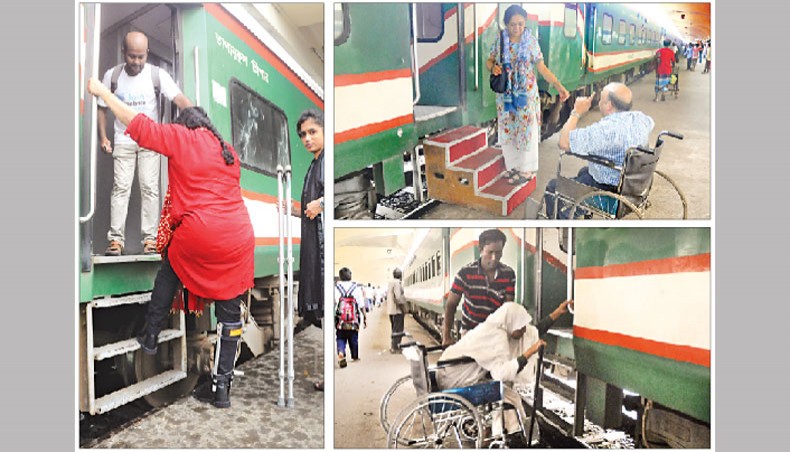Most of rly platforms not user-friendly
Most of the platforms of Bangladesh Railway are not friendly to the passengers, especially those with disabilities, when accidents are frequent because of the faulty design of the structures.
Huge gap between the platforms and trains or no platform at all at many places leads to regular and sometimes fatal accidents, transport experts point out.
The passenger-unfriendly platforms and stations having no platforms are common not only in the outlying districts but also in important stations including those in Dhaka.
At most of the platforms, ramps and stairs are not provided for passengers with disability, elderly, women and children while passengers and rights activists have alleged that stairs are provided only when any VIP gets on trains.
The BR suspended two of its officials at Ullapara station in Sirajganj after the local lawmaker fell from the stair of a train on September 4.
New Age correspondent in Sirajganj reported that the distance between the platform and the train’s stair is about one foot at the station, which was a reason behind the accident.
On September 3, Latifa Razzak, wife of Abdur Razzak from Ghat Farhad Beg area, fell off the Dhaka-bound Turna Nishitha Express at Battali rail station in Chittagong after she tried to get off in a hurry when the train started to run.
The train crushed her legs and she died later on the night while New Age correspondent in Chittagong reported that the gap between the platform and train was also too big.
At the capital’s Kamalapur, airport and Tejgaon rail stations trains often stop on the tracks with no platforms and passengers have to struggle to get on the trains from ground which is almost impossible for women and elderly people.
It is a common scene at Kamalapur station, the country’s main railway station, where people with disability and elderly people are carried by others into the trains because of the excessive gap between the train stair and the platform.
During any festival, many women and elderly people fail to board trains in absence of any stair or ramp.
Airport rail station’s assistant station master Md Alamgir Hossain said he did not know how many wheel chairs or stairs were at the platform.
New Age correspondent in Rajshahi reports that the platforms at rail stations including Abdulpur junction, Arani and Sardah stations are shorter than the trains.
Hasibuzzaman, a Rajshahi University student, said that recently he boarded the Kapotaskh Express on Khulna-Rajshahi route in Jessore station while the train stopped far away from the platform.
‘A girl fell off the train while trying to get on it and narrowly escaped a fatal accident,’ he added.
The standard distance between the platform and a train’s stair is five inch, according to officials.
But in Bangladesh, platform height for metre gauge trains is between one foot and four inches and one foot and six inches, which is between two feet and three inches and two feet and six inches for broad gauge trains.
To balance the distances the railway keeps the height of platforms for dual gauge tracks at two feet to facilitate passengers of both trains.
Among 4,185.06 kilometres of rail tracks only 14 per cent are now dual gauge tracks.
Work for a Better Bangladesh, Trust project officer Atiqur Rahman said the country’s most of the railway platforms were not friendly towards passenger and physically challenged people.
He said that most of the platform did not have wheelchairs facilities while the platforms at Jamalpur, Sylhet, Chittagong and Rajshahi were too high for most of the passengers to mount it.
‘Whenever any VIP gets on a train, we always find railway staff providing them with staircases,’ he said and demanded portable staircases and ramps for other passengers who need them.
BR additional director general (operation) Md Habibur Rahman told New Age that many railway rolling stocks were in service even after their economic life had expired.
If any improvement was done to the platforms, these aged rolling stocks must be put out of service, he observed.
Currently, railway’s about 68 per cent locomotives, about 46 per cent carriages and about 45 per cent wagons are still in service even after their economic life had expired, shows mechanical department statistics.
Habibur said it would take at least 20 years to change all platforms to a unified and standard shape.
BR in its draft Master Plan (2016-2045) proposed two projects to extend and renovate all its platforms and platform sheds.
Bangladesh University of Engineering and Technology’s civil engineering department professor Md Shamsul Hoque, in his observation on the draft, recommended that railway raise height of platforms to make it compatible with commuter train services.
News Courtesy: www.newagebd.net











